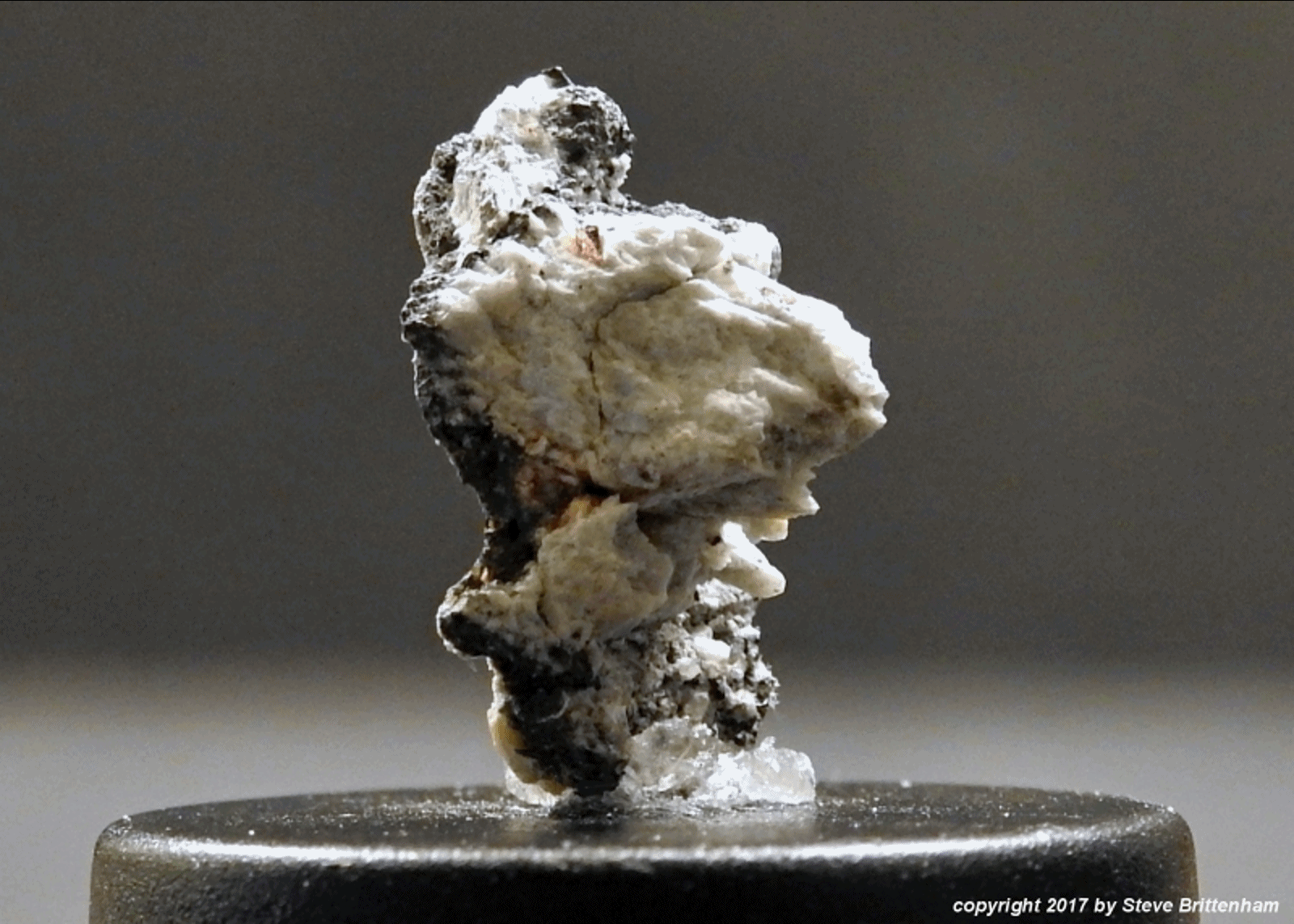|
Roll Overs:
#1
#2
|

|
|
Copyright (c) Steve Brittenham.
|
1.3 gram fragment. Aubrite
TKW 1.1 tons (1000 kg). Observed fall February 18, 1948, near Norton, Kansas, USA.
  
Steve writes:
In honor of America's birthday, I told Paul I could do a 4th of July
submission that showed red fluorescence of a white U.S. meteorite with blue
UV reflections (alright, more like magenta, white, and purplish-blue, but
hopefully close enough!). So with that introduction, I humbly offer
this example of the Norton County meteorite. (And my apologies to Paul's
audience from other countries that might not get the red, white, and blue
reference.)
Norton County is a well-known aubrite that has already appeared on a half
dozen wonderful MPODs. The piece in this submission doesn't add anything by
way of size or obviously unique features, but since not a lot of people I've
talked to are aware of it, I thought it would be fun to share some examples
of Norton County's fluorescence.
Aubrites are principally composed of enstatite, but that mineral in Norton
County contains much less iron, making it white as compared to the green to
brown or even almost dark gray colors of some of the other aubrites. The
even lower iron content crystals fluoresce under shortwave UV but under
normal light are hard to differentiate from the adjacent non-fluorescing
enstatite.
To illustrate this phenomenon, the animated gif in Photo 1 shows a 1.3 gram Norton County fragment under both normal white
and shortwave UV lights (for reference, the diameter of the pedestal is one
inch). The photo setup was a bit difficult to implement with the equipment
I have and as a consequence the angles of these lights were necessarily
different, but the effect is nonetheless still evident. The purplish-blue
illumination was not visible to the naked eye, but to the camera's 15 second
exposures the effect is likely similar to the non-fluorescent reflections
often seen when using long wave UV light. Over the small fluorescent areas
of this piece, this pervasive purplish-blue glow tended to make the
naturally yellowish-orange fluorescence appear magenta in the long
exposures.
As an aside, Norton County is my only aubrite, and none of my other 300 or
so meteorites fluoresce. In fact only five of my eighteen pieces of that
meteorite do, possibly suggesting that even in Norton County, the
fluorescing minerals are somewhat rare. Similarly, a couple of years ago I
was at Bob Falls' house and out of curiosity tested a large slice of his
Pena Blanca Springs aubrite. A handful of very small areas did fluoresce,
possibly indicating that this phenomenon - though sparse when present - is a
common attribute of aubrites that exhibit white enstatite. I also have a
Cumberland Falls thin section that I wanted to check, but like my Norton
County thin section, it's glass also has hazing problems. |
Click to view larger photos
#1
#2
|
Found at the arrow (green or red) on the map below
View Larger Map |
|
| |
John Mixter
7/4/2022 11:21:46 AM |
I really enjoyed the read and presentation! |
Anne Black
7/4/2022 10:57:38 AM |
Steve, I have a large slice of Pena Blanca, if you ever want to look at it, since we are in the same state. Happy 4th, everybody!
|
Steve Brittenham
7/4/2022 9:49:14 AM |
Since this post, I picked up a very large piece of Norton County and a better UV light. It's iron-depleted enstatite flouresces a bright yellow under long wave (I'm told that iron quenches fluorescence in the rest of the enstatite). I also acquired a piece of Bob's Pena Blanca Springs (another aubrite) with clasts that fluoresce under shortwave UV. I heard rumors that Cumberland Falls (yet another aubrite) fluoresces too, but I'd be interested if any of Paul's readers knew first hand if that was true, as well whether anyone has any other aubrites that fluoresce. |
John Lutzon
7/4/2022 9:29:37 AM |
Thanks again Steve,Paul. Happy 4th ! |
Alexander Natale
7/4/2022 5:24:31 AM |
Very interesting post, Thank You and Happy 4th of July to everyone.
|
jim brady
7/4/2022 3:39:42 AM |
pretty cool--happy independence day America--let them fireworks rip--stay safe y'all |
| |
|